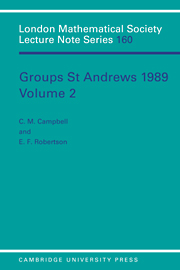Book contents
- Frontmatter
- Contents
- Preface
- Introduction
- 17 A survey of recent results on projective representations of the symmetric groups
- 18 Some applications of graded diagrams in combinatorial group theory
- 19 Rational growth of wreath products
- 20 The modular group and generalized Farey graphs
- 21 On the n-centre of a group
- 22 Existentially closed finitary linear groups
- 23 Permutability and subnormality of subgroups
- 24 Some applications of powerful p-groups
- 25 Combinatorial aspects of finitely generated virtually free groups
- 26 Problems in loop theory for group theorists
- 27 Sylow theory of CC-groups: a survey
- 28 On the minimal number of generators of certain groups
- 29 Lie properties of modular group algebras
- 30 Observations on a conjecture of Hans Zassenhaus
- 31 The Fibonacci groups revisited
- 32 Galois groups
- 33 Infinite simple permutation groups - a survey
- 34 Polynomial 2-cocyles
24 - Some applications of powerful p-groups
Published online by Cambridge University Press: 13 March 2010
- Frontmatter
- Contents
- Preface
- Introduction
- 17 A survey of recent results on projective representations of the symmetric groups
- 18 Some applications of graded diagrams in combinatorial group theory
- 19 Rational growth of wreath products
- 20 The modular group and generalized Farey graphs
- 21 On the n-centre of a group
- 22 Existentially closed finitary linear groups
- 23 Permutability and subnormality of subgroups
- 24 Some applications of powerful p-groups
- 25 Combinatorial aspects of finitely generated virtually free groups
- 26 Problems in loop theory for group theorists
- 27 Sylow theory of CC-groups: a survey
- 28 On the minimal number of generators of certain groups
- 29 Lie properties of modular group algebras
- 30 Observations on a conjecture of Hans Zassenhaus
- 31 The Fibonacci groups revisited
- 32 Galois groups
- 33 Infinite simple permutation groups - a survey
- 34 Polynomial 2-cocyles
Summary
In my talk in the second “Groups – St Andrews”, I outlined the answer to a question that was asked by Jim Wiegold in the first such conference. Another application of the same methods was reported in the same meeting by Alex Lubotzky (see Sections 6 and 3 below). Now, in the third “Groups – St Andrews”, I would like to report on further applications. Some of these were, in their turn, inspired by Dan Segal's talk in the second conference, and include a solution to a problem he asked.
As the reader will see, the proofs (which are due to A Lubotzky, D Segal, and the author) apply a variety of techniques and results. In addition to the powerful pgroups mentioned in the title, main new ingredients are the application of p-adic Lie groups, and counting the number of generators of subgroups. These three themes are closely related.
Sections 2 to 4 contain applications to infinite groups, and section 5 to finite pgroups, while the last section, which also discusses finite p-groups, is discursive and speculative.
Powerful p-groups
Definition. A finite p-group G is powerful, if either p is odd and GP contains G' or p=2 and G4 contains G'.
(Gn and G' denote, respectively, the subgroup generated by nth powers and the commutator subgroup.)
We had several reasons for considering such groups. First, they occur quite often. E.g. if G is a regular p-group, then GP is powerful. The same is true if G satisfies the conditions, weaker than regularity, that were studied in [Ml]. A still more general example is given in Theorem 12 below.
- Type
- Chapter
- Information
- Groups St Andrews 1989 , pp. 370 - 385Publisher: Cambridge University PressPrint publication year: 1991
- 3
- Cited by



